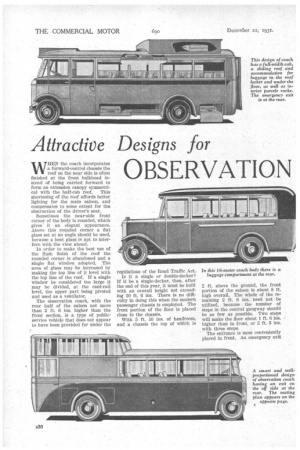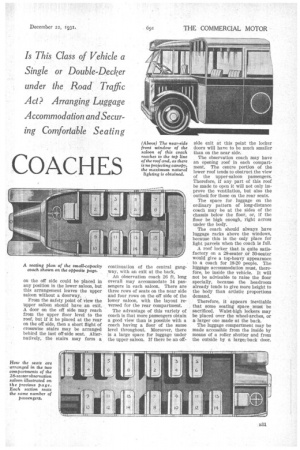Attractive Designs for
Page 44

Page 45

If you've noticed an error in this article please click here to report it so we can fix it.
OBSERVATION COACHES
WHEN the coach incorporates a forward-control chassis the roof on the near side is often finished at the front bulkhead instead of being carried forward to form an extension canopy symmetrical with the half-cab roof. This shortening of the roof affords better lighting for the main saloon, and compensates to some extent for the obstruction of the driver's seat.
Sometimes the near-side front corner of the body is rounded, which gives' it an elegant appearance. Above this rounded corner a flat glass set at an angle should be used, because a bent glass is apt to interfere with the view ahead.
In order to make the best use of the flush finish of the roof the rounded corner is abandoned and a single flat window adopted. The area of glass may be increased by making the top line of it level with the top line of the roof. If a single window be considered too large it may be divided, at the cant-rail level, the upper part being pivoted and used as a ventilator.
The observation coach, with the rear half of the saloon not more than 2 ft. 6 ins, higher than the front section, is a type of publicservice vehicle that does not appear to have been provided for under the regulations of the Road Traffic Act.
Is it a single or double-decker? If it be a single-decker, then, after the end of this year, it must be built with an overall height not exceeding 10 ft. 6 ins. There is no difficulty in doing this when the modern passenger chassis is employed. The front portion of the floor is placed close to the chassis.
With 5 ft. 10 ins, of headroom, and a chassis the top of which is
2 ft. above the ground, the front portion of the saloon is about 8 ft. high overall. The whole of the remaining 2 ft. 6 ins, need not be utilized, because the number of steps in the central gangway should be as few as possible. Two steps will make the floor about 1 ft. 6 ins. higher than in front, or 2 ft. 3 ins. with three steps.
The entrance is most conveniently placed in front. An emergency exit on the off side could be placed in any position in the lower saloon, but this arrangement leaves the upper saloon without a doorway.
From the Safety paint of view the upper salbon should have an exit. A door on the off side may reach from the upper floor level to the roof, but if it be placed at the rear on the off side, then a short flight of crosswise stairs may be arranged behind the last off-side seat. Alternatively, the stairs may form a
continuation of the central gangway, with an exit at the back.
• An observation coach 26 ft. long overall may accommodate 14 passengers in each saloon. There are three rows of seats on the near side and four rows on the off side of the lower saloon, with the layout reversed for the rear compartment.
The advantage of this variety of coach is that more passengers obtain a good view than is possible with a coach having a floor of the same level throughout. Moreover, there is a large space for luggage under the upper saloon. If there be an off
side exit at this point the locker doors will have to be much smaller than on the near side.
The observation coach may have an opening roof in each compartment. The centre portion of the lower roof tends to obstruct the view or the upper-saloon passengers. Therefore, if any part of this roof be made to open it will not only improve the ventilation, but also the outlook for those on the rear seats.
The space for luggage on the ordinary pattern of long-distance coach may be at the sides of the chassis below the floor, or, if the floor be high enough, right across under the body.
The coach should always have luggage racks above the windows, because this is the only place for light parcels when the coach is full.
A roof locker that is quite satisfactory on a 28-seater or 30-seater would give a top-heavy appearance to a coach for 18-20 people. The luggage accommodation must, therefore, be inside the vehicle. It will not be advisable to raise the floor specially, because the headroom already tends to give more height to the body than artistic proportions demand.
Therefore, it appears inevitable that some seating space must be sacrificed. Waist-high lockers may be placed over the wheel-arches, or a larger one made at the back.
The luggage compartment may be made accessible from the inside by means of a roller shutter and from the outside by a large.: back door.




























































































